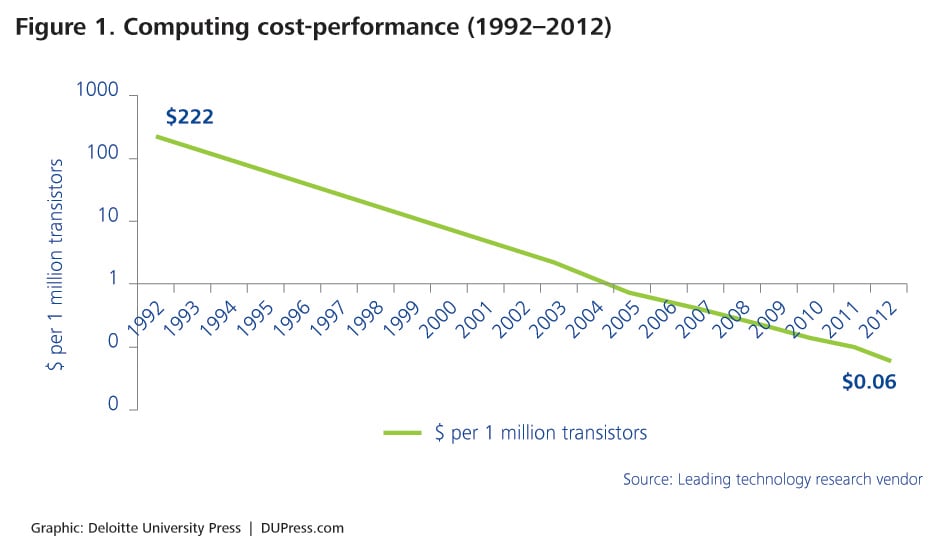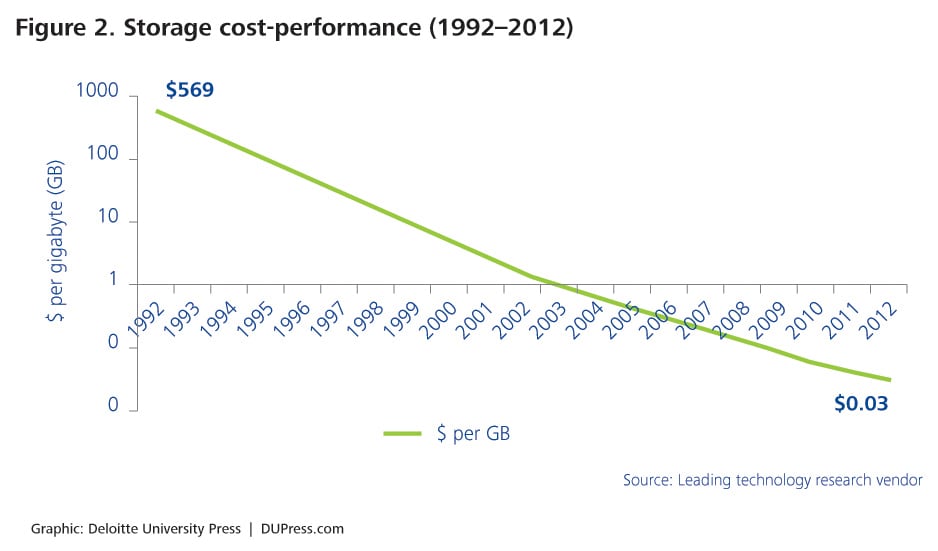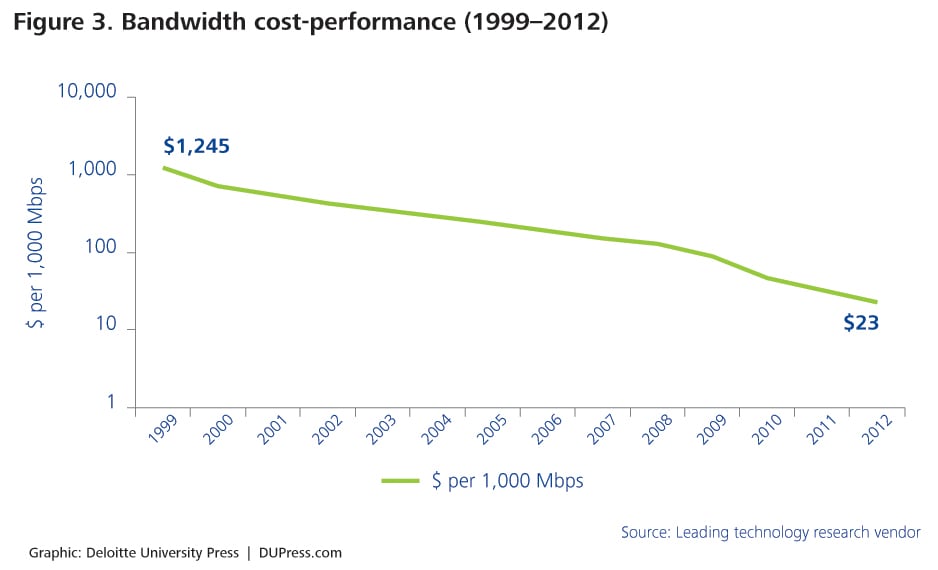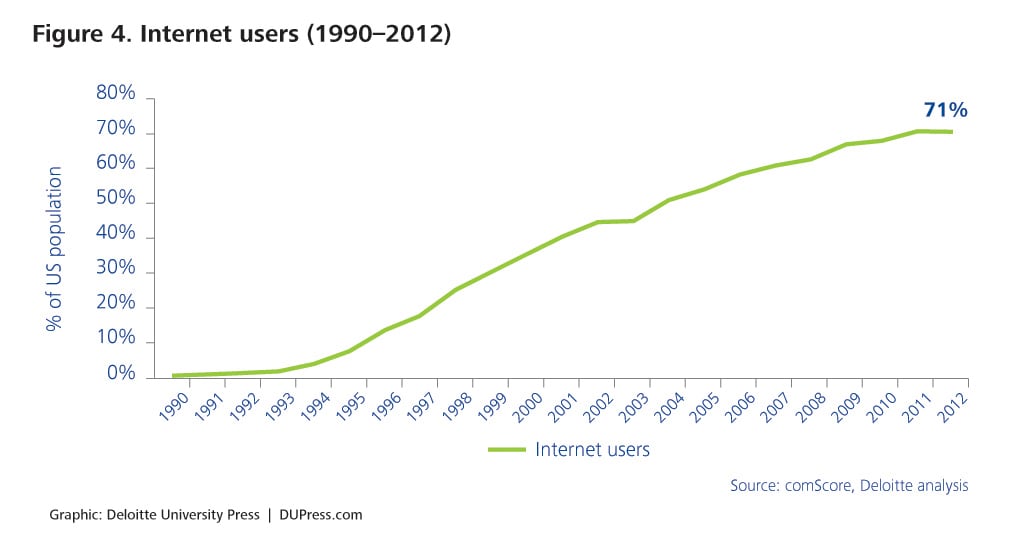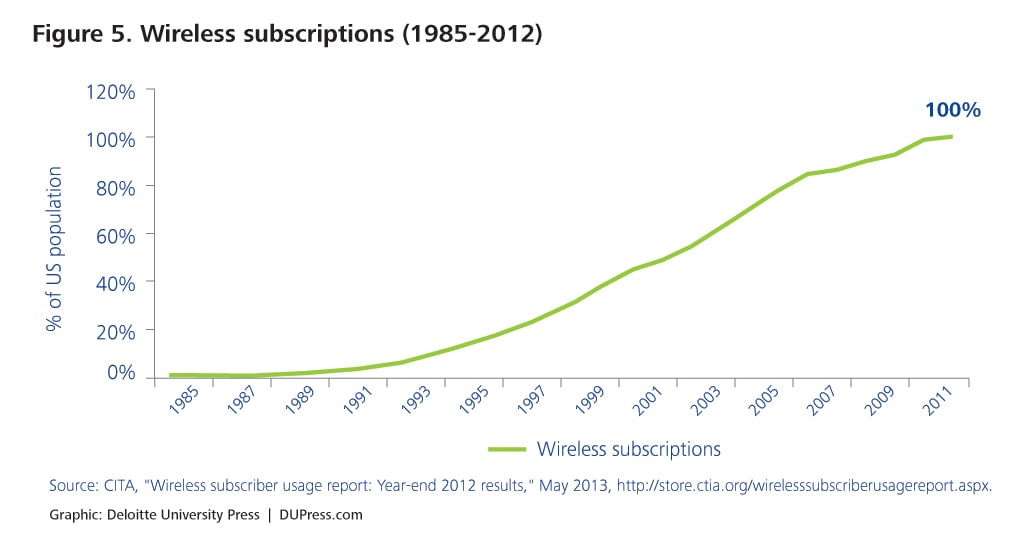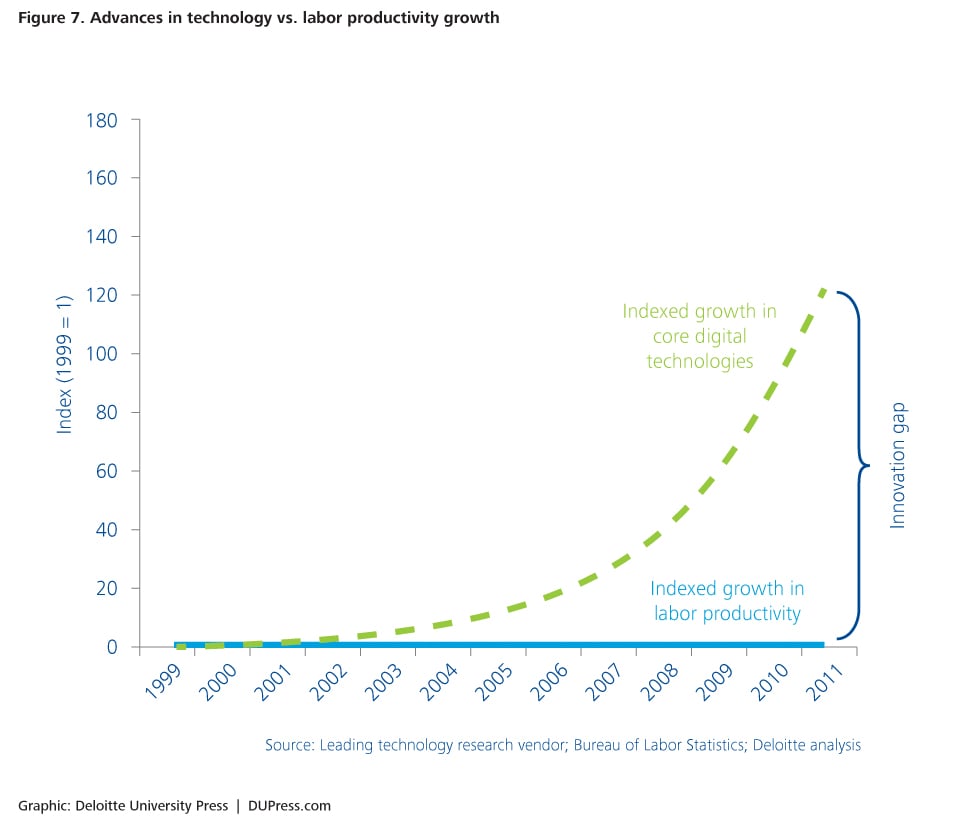From exponential technologies to exponential innovation has been saved

From exponential technologies to exponential innovation Report 2 of the 2013 Shift Index series
05 October 2013
Exponentially advancing digital technologies have led to exponentially accelerating innovation, making the environment increasingly difficult to navigate—but also opening the door to opportunity.
ABOUT THE SHIFT INDEX
We developed the Shift Index to help executives understand and take advantage of the long-term forces of change shaping the US economy. The Shift Index tracks 25 metrics across more than 40 years. These metrics fall into three areas: 1) the developments in the technological and political foundations underlying market changes, 2) the flows of capital, information, and talent changing the business landscape, and 3) the impacts of these changes on competition, volatility, and performance across industries. Combined, these factors reflect what we call the Big Shift in the global business environment.
For more information, please go to www.deloitte.com/us/shiftindex
 EXECUTIVE SUMMARY
EXECUTIVE SUMMARY
Exponential improvement in core digital technologies is fueling exponential innovation. The cost-performance of three core digital technology building blocks—computing power, storage, and bandwidth—has been improving at an exponential rate for many years. As the rate of improvement accelerates, we are experiencing rapid advances in the innovations built on top of these core “exponential” technologies. The current pace of technological advance is unprecedented in history and shows no signs of stabilizing as other historical technological innovations, such as electricity, eventually did.
These rapid advances have the power to disrupt industries. The disruptive potential of exponential technologies is amplified when they interact and combine in innovative ways. The impact is further amplified when technologies coalesce into open platforms and ecosystems. These reduce the investment and lead time required to drive the next wave of innovation into markets by enabling people and technologies to rapidly build on previous waves of innovation.
Exponential innovations are rapidly moving across boundaries, causing traditional definitions to blur and blend. They are combining with entirely new categories of technology such as molecular biology and materials science, enabling advances and causing disruptions across an ever-expanding range of industries, functions, and disciplines.
The changes wrought by exponential innovation are increasing the pressure on companies to perform. Yet the same platforms and ecosystems that amplify exponential innovations can also help institutions and individuals connect with each other, empowering them to combine technologies, practices, and business models in interesting ways to create a seemingly endless array of new products, services, businesses, and new technologies. This ability to combine and recombine technologies and people and build on existing innovations is the core of exponential innovation.
To better understand this year’s Shift Index, as well as to learn about ways to begin to create and capture value in this environment, we invite you to take a deeper look at our 2013 Shift Index research reports:
Unlocking the passion of the explorer
Success or struggle: ROA as a true measure of business performance
2013 Shift Index metrics: The burdens of the past
Lessons from the edge: What companies can learn from a tribe in the Amazon
The continuing exponential cost-performance improvement of core digital technologies is unprecedented in history. The interactions among these digital pillars amplify their disruptive potential.
Introduction
In May 2013, another impact from disruption hit the automobile industry. The 100-year-old industry, born of another series of disruptions—the assembly line and electricity—faces change on an unprecedented scale. The disruptor: Tesla Motors. The impact: Tesla’s market value surpassing that of Fiat, Europe’s fourth-largest automaker.1 Tesla Motors, barely 10 years old and with only one model in full production, rode the wave of exponential technology improvement to become more valuable than a company dating back to the turn of the twentieth century with operations in 40 countries and a commercial presence in 140 countries.2
To achieve this feat, Tesla made many technical and operational advancements: production lines designed from scratch, new in-vehicle software that can be automatically updated, a new sales process to profitably generate demand in target segments. Tesla developed a suite of innovations to better align with customer needs and disrupt incumbent automakers. Powerful onboard computers process the complex software that runs each vehicle management system. Increased bandwidth allows updates to be pushed to each vehicle, quickly and safely. The technologies combine to create a seamless and compelling driver experience that is difficult for other automakers to imitate.
We cannot grasp the full potential of exponential technologies until we explore the interactions across them.
Each of these advances was possible because of the sustained exponential cost-performance improvement of three core digital technology building blocks: computing power, data storage, and bandwidth.3 Tesla’s story highlights the unprecedented pace and magnitude of disruption being caused by rapid advances in these core technologies. Moreover, the implications of exponential technologies cannot be understood by looking at the individual parts. Too many research reports focus on advances in the individual technologies but tend to miss a deeper and more powerful development: the increasing ability of these technologies to amplify the performance of each other in unexpected ways that disrupt traditional boundaries. We cannot grasp the full potential of exponential technologies until we explore the interactions across them.
This report maintains that:
- The impact of exponential technologies is further amplified when they coalesce into open platforms and ecosystems. These reduce the investment and lead time required to drive the next wave of innovation into markets by enabling people and technologies to rapidly build on previous waves of innovation.
- Exponential innovations in digital technology are rapidly moving across boundaries. They are combining with entirely new categories of technology such as molecular biology and materials science, enabling advances and causing disruptions across an ever-expanding array of industries, functions, and disciplines.
Through a virtuous cycle—technological improvement enabling innovation, which in turn serves as a platform for further technological improvement and innovation—exponentially advancing technologies lead to exponentially accelerating innovation. For companies, this accumulation of technological advances, and the consequent layering of innovation upon innovation, can pose the threat of disruption—but can also open the door to great opportunity. And the technologies show no sign of stabilizing.
2013 Shift Index foundational metrics
The cost of three core digital technology capabilities—computing power, data storage, and bandwidth—relative to their performance has been decreasing exponentially and at a faster rate than that of previous technological advances such as electricity and telephones. The increasing affordability of digital technology, coupled with wireless networks and powerful mobile devices such as smartphones and tablets, has created an increasingly broad platform for users to connect and communicate anywhere and at any time.
The cost of computing power has decreased significantly, from $222 per million transistors in 1992 to $0.06 per million transistors in 2012. The decreasing cost-performance curve enables the computational power at the core of the digital infrastructure.
Similarly, the cost of data storage has decreased considerably, from $569 per gigabyte of storage in 1992 to $0.03 per gigabyte in 2012. The decreasing cost-performance of digital storage enables the creation of more and richer digital information.
The cost of Internet bandwidth has also steadily decreased, from $1,245 per 1000 megabits per second (Mbps) in 1999 to $23 per 1000 Mbps in 2012. The declining cost-performance of bandwidth enables faster collection and transfer of data, facilitating richer connections and interactions.
Additionally, the use of the Internet continues to increase. From 1990 to 2012, the percent of the US population accessing the Internet at least once a month grew from near 0 percent to 71 percent. Widespread use of the Internet enables more widespread sharing of information and resources.
More and more people are connected via mobile devices. From 1985 to 2012, the number of active wireless subscriptions relative to the US population grew from 0 to 100 percent (reflecting the fact that the same household can have multiple wireless subscriptions). Wireless connectivity is further facilitated by smartphones. Smart devices made up 55 percent of total wireless subscriptions in 2012, compared to only 1 percent in 2001.4
The continuing development of these foundational elements magnifies exponential innovation, offering opportunities for organizations that are able to tap into these trends.
The lack of stability
In prior episodes of technological change, periods of rapid innovation and upheaval were followed by periods of relative calm that allowed industries to stabilize—the S-curve pattern described by Carlota Perez, a leading specialist in technology and socioeconomic development.5 Technical revolutions involving electricity, the telephone, and the internal combustion engine experienced sharp bursts of innovation in underlying technologies that then stabilized.6 Clear winners emerged and remained at or near the top for decades.
This paradigm no longer exists. The cost-performance improvement in core digital technologies shows no signs of slowing down, at least in the foreseeable future.
With the Model S, Tesla proved that it could produce a technologically advanced product that could compete with even its most established competitors. Underlying the finished vehicle, a series of innovations on everything from how the cars are assembled to how they are maintained helped Tesla gain traction in a difficult industry. On the factory floor, for instance, the latest automation and sensor technologies ensure a flexible, cost-effective production system. The vehicle management system is scalable and was designed entirely in-house to provide a unique ownership experience for each vehicle owner.7 None of this would have been possible without exponentially improving capabilities in computing power, storage, and bandwidth.
GLOBAL INTERNET ADOPTION
Given current trends in innovation and disruption, it is easy to forget that over 60 percent of the world’s population still lacks reliable Internet access.8 As Google’s executive chairman, Eric Schmidt, has said, “For every person online, there are two who are not.”9 Large segments of Africa, Latin America, and Asia still have just 0 to 50 percent Internet adoption (defined as access to the Internet), compared with developed economies like the United States, where 71 percent of the population accesses the Internet at least once a month and more than 95 percent has Internet access. Even booming economies like Mexico have lower Internet access rates than one might expect. In 2011, only 36 percent of the people in Mexico had access to the Internet.10
Various technology executives, however, claim that by the end of this decade, everyone on earth will be connected.11 This future depends on many factors—increased wealth, telecommunications infrastructure, political stability—yet there remains tremendous potential for innovation as more and more of the world comes online.12
As dependable, ubiquitous Internet access spreads across the globe, increasing disruption and innovation will surely follow. According to a report by Cisco Systems, Internet traffic worldwide will grow threefold by 2017, with non-PC devices like smartphones and tablets predicted to drive the traffic.13 Internet access through mobile phones will be especially prevalent in developing economies. Africa exemplifies this trend: Google reports that more people have access to mobile phones in Africa than to electricity. In South Africa, 25 percent of weekly online searches are via mobile devices, rising to 65 percent on weekends. In terms of Internet content, as network speed increases, information will increasingly be streamed through video.14 Likewise, the “Internet of Things”—systems such as automobile technology and IP surveillance devices that generate data and send it over networks—is expected to gain prominence.15 Increased access to the Internet, a fundamental catalyst of exponential innovation, will also likely lead to disruptions in key markets in health, transportation, and finance.
In Africa, among the regions that have the lowest Internet penetration, telecom operators provide mobile payment services to millions of people who previously had no banking account but do have a mobile phone. The widespread acceptance of mobile payments in Africa is spurring entrepreneurship, exponential innovation, and business opportunities. Safaricom, the Kenyan mobile phone operator that successfully introduced the mobile payments service M-Pesa, now offers mobile payments-based savings and loans. This makes micro-business financing available to anyone with a mobile phone. M-Pesa is already being used by almost 15 million people out of a population of 19 million adults.
On the other side of the globe, deep in the Amazon rainforest, smartphones are being used by indigenous communities to combat the threat of deforestation, record and preserve indigenous culture, and even support education efforts for indigenous youth. Communities like the Paiter-Surui in Rondonia, Brazil, have been working with Google since 2007 to bring customized Android mobile devices into remote parts of their territory to develop accurate maps of their land, capture illegal logging as it occurs, notify governmental authorities to the illicit activity while it’s going on, and support cultural preservation efforts by documenting spiritual and religious ceremonies.16
In addition, open collaboration platforms are providing freelancers, entrepreneurs, students, and corporate institutions global reach. These collaboration platforms create unseen opportunities on a scale that was previously only achievable by multinational corporations. These disruptions are occurring even as Internet penetration remains low in many regions of the world. As more of the developing world comes online, the impact of its productive capacity will further amplify the pace of exponential innovation.
In fact, most of the tools we use in industry and in everyday life are powered by the foundational forces of computing power, storage, and bandwidth. As more innovators and organizations experiment with these technologies, individually and in combination, the pace of innovation and disruption may increase across all industries. Though any given disruption may look like mere surface turbulence or yet another market adjustment, each disruption is actually a symptom of how technology’s accelerating cost-performance improvement is rewiring the nature of collaboration and innovation.
The rapid advance in core digital technologies is even reshaping the nature of competition itself—in ways that encourage disruptive innovation.
As tempting as it may be to address surface disruptions in the short term, more lasting value can come from understanding and harnessing the forces underlying them. Just as the speed and direction of the wind in any given hour is highly variable and not particularly useful for charting a course across the ocean, the deeper trends shaping the environment are more useful for navigating the long-term future than are the surface disruptions.
Developments in the telecommunications industry over the past decade highlight the marketplace challenges of keeping up with exponentially improving technology within an industry. New solutions that sidestepped the constraints imposed by pre-Internet, pre-personal computing services ravaged stable revenue models. Shifts to mobile telephony and VoIP forced service providers to continually invest in network upgrades while also developing new revenue streams. One major telecommunications company undertook six major cellular technology deployments (TDMA, EDGE, UMTS, HSDPA, HSPA, and LTE) in the last 10 years at a cost of several billion dollars per year.17 Today, social media and other new communications models create substitutes and put further pressure on telecommunications companies’ revenue streams. Information services such as 411 that drove revenue a decade ago are virtually nonexistent today due to widespread Internet access and the proliferation of smartphones.18
For some companies, computing power and bandwidth themselves have become a source of competitive advantage. The New York Stock Exchange (NYSE) has operated since 1817, but more and more, the actual trading of stocks occurs not on the floor of the exchange but on virtual exchanges powered by huge server farms and data warehouses. High-frequency trading algorithms (HFTs) process huge numbers of transactions in incredibly short periods of time, largely without human supervision or control. Large investment firms lease space as close to the NYSE’s servers as possible in order to gain a millisecond’s advantage over competitors’ algorithms. The NYSE itself made significant investments in a facility to house these server farms. The pace and voracity of this competition is leading to the construction of even faster server farms and information channels. Even so, the advantage these firms gain from hypercompetitive technology adoption is fleeting. As more and more firms rush into HFT, the information flows underlying the trades make the markets more efficient, making it harder and harder for firms to achieve the same levels of profit.19
The rapid advance in core digital technologies is even reshaping the nature of competition itself—in ways that encourage disruptive innovation. The combination of nearly instantaneous information flows and the ability to share and collaborate globally with minimal difficulty or transaction costs is lowering the barriers to market entry. New media and digital marketplaces allow buyers and sellers to find each other more and more easily. While some businesses, like automotive manufacturing, will continue to be capital-intensive, new production technologies and greater volumes of digital information transmission are decreasing the minimum efficient scale for entry. Legitimate competitors can emerge with little capital investment and almost no risk.
Now more than ever, lower risks and cost exposures allow competitors to take advantage of open flanks, especially of large enterprises encumbered by legacy practices. When portfolio performance slows and expenditures must rise just to cover the costs of defending legacy revenue streams against the tides of change, it can be easy to lose sight of smaller and nascent competitors. Furthermore, older institutions accustomed to analyzing threats and opportunities within narrow silos can miss the broader opportunities that emerge from the cross-domain flows of knowledge enabled by dynamic information ecosystems.
3D microchips and next-generation computing
“While the hunger for additional and improved features and processing power is irrepressible, how much more can we squeeze into one microchip?”20
Many believe that a new wave of innovation and disruption will be unleashed when 3D microchips become cost-competitive. 3D microchips are innovative in that both their form and function are erected in 3D space. The chips are stacked, allowing more transistors to be packed into the same volume. This stacking creates multiple pathways for digital information to move, while also reducing the distance traveled. Rather than just moving across a single plane as with traditional microchips, digital information can also move vertically within a 3D chip. Less advanced integrated circuits, although also physically erected in 3D space, are still being positioned in two dimensions like points on a grid.21
The potential benefits of 3D microchips over conventional microchips include higher performance with greater energy efficiency. 3D microchips can deliver 10 times the computing power of a conventional microchip, while using 40–50 percent less electricity at constant computing rates.22
3D microchips could be used to spur an age of cognitive computing, exemplifying the potential exponential progress of artificial intelligence. Equipped with cognitive computing capabilities, computers could potentially “learn” and “think”; they may also be able to recognize patterns, query back, and request additional information. This potential is especially important in light of the increasing emphasis on big data and the need to decode and systematize it.23 Deep learning algorithms require an astronomical amount of computing power; 3D chips are part of the answer, although learning how to scale computing across hundreds of thousands of processors in the cloud will also be key.
High production costs and process technology limitations remain crucial challenges for 3D chip manufacturers. In addition, Moore’s Law has proved durable with conventional microchips, reducing the immediate demand for additional processing power.24 Still, if and when the cost-performance curve for conventional microchips flattens out, 3D microchips will be waiting in the wings, ready to power future waves of innovation.
The rise of the platform
Advances in information technologies have also fundamentally changed the way products and services are conceived and created. Both driven and empowered by rapidly developing technological tools, companies are developing new practices and models that seek to decentralize innovation and invite participation from beyond the organization’s walls.
Rather than create proprietary products, some companies are developing and deploying platforms that others can build upon. The result has been to increase the speed and decrease the cost of innovation, since the standardized interfaces and plug-in architectures that such development platforms establish can be extended by third-party innovators to meet more specialized needs. New functionality can be added to the periphery at little additional expense, extending the platform’s value and surfacing new revenue opportunities. Costs that might prohibit smaller entrants are already embedded in the infrastructure, making it easier for platform-based innovators to scale up quickly to seize niche or emerging opportunities, or simply to better serve the core market segment. Cloud computing capabilities further extend the capacity for innovation by turning core technological capabilities into rentable shares that easily interconnect with existing business systems. Extensible technology frameworks make it possible to bring together ever larger networks of contributors, facilitating exponential innovation and amplifying the impact of improvements in technological cost-performance.
With an open platform, although the platform creator incurs the expense of building the core infrastructure, third-party innovators become stakeholders in its success. Hence, platforms allow an organization to leverage the efforts of others participating in its growth. This shared interest in the platform’s performance becomes increasingly important as the complete set of capabilities and knowledge to sense and act becomes less likely to reside entirely in one organization. Platforms thus become fertile breeding grounds for “business ecosystems,” a concept that is becoming more important than ever.
Ecosystems fall into two broad categories: static and dynamic. Static ecosystems, such as an automotive supply chain, aggregate and coordinate a fixed set of resources, typically delivering the greatest benefit to the ecosystem organizer. In contrast, dynamic ecosystems, such as the Linux open-source development community, explicitly seek to create environments and relationships where diverse participants can learn and advance more rapidly by collaborating.
Today’s technology makes it much easier to create and manage dynamic ecosystems than in the past: New developments in social software, cloud computing, and other technologies can lower the cost of managing the complexity that comes with a large number of diverse participants.25 Partly because of this, dynamic ecosystems, in which participants learn from each other and create superior outcomes for participants, are becoming more and more important for value creation. For instance, by integrating both enterprises and customers into development, platforms and ecosystems enable shorter product release cycles. The ability to engage in rapid prototyping informed by constant user testing and feedback also gives organizations the means to pursue exponential innovation without incurring exponential costs.
As an example of a platform-based dynamic ecosystem, consider the recent proliferation in the number of start-ups innovating in the personal transportation industry (figure 6). For years, most consumers who wanted to use an automobile for personal transportation had three basic choices. They could buy a car—if they were willing to incur the costs and burdens of ownership. They could rent one from an auto rental agency—if they could arrange to get to one of its locations. Or they could hire a taxi—if they happened to be in an area with taxi service.
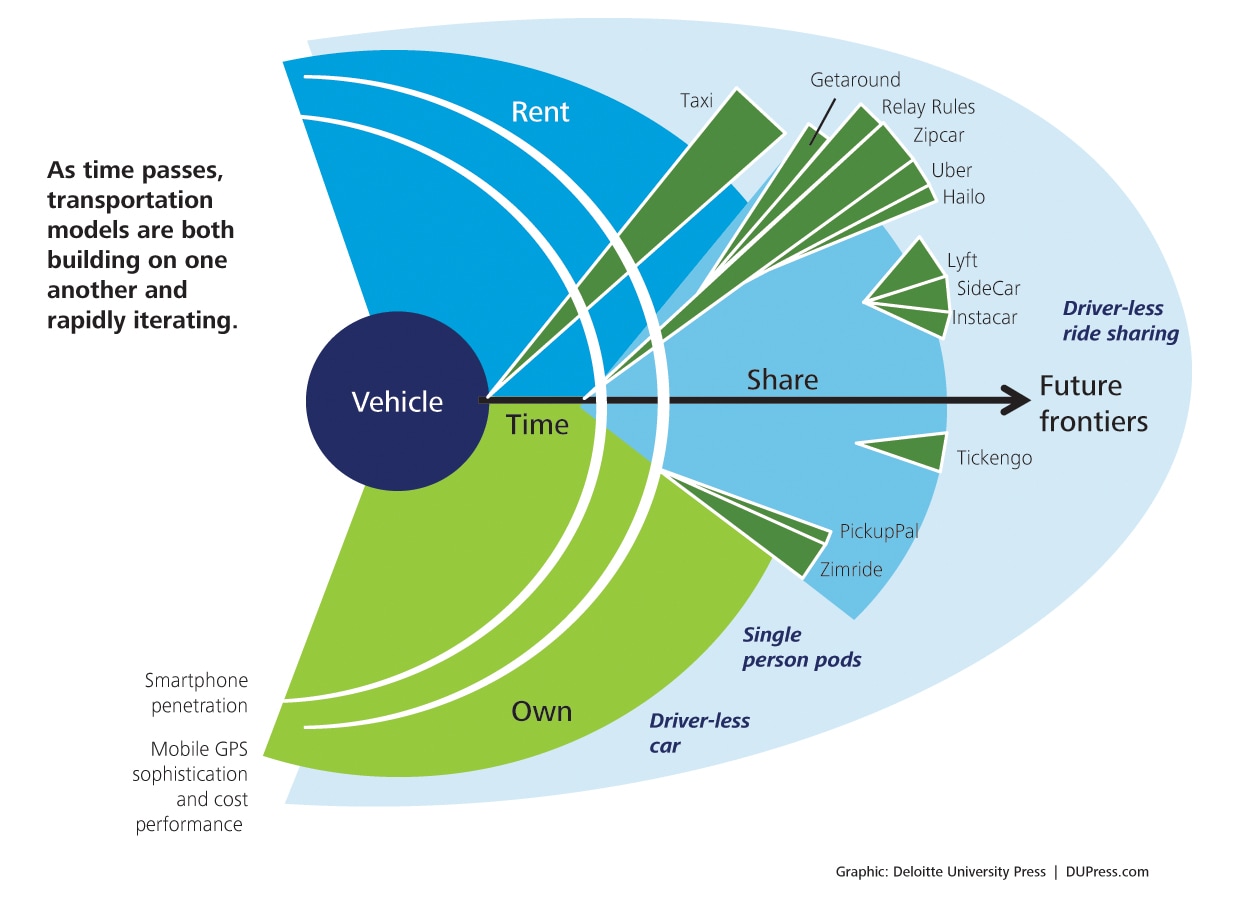 Figure 6. Disruption in the personal transportation industry
Figure 6. Disruption in the personal transportation industry
Today, however, car-seeking consumers can select from a wide variety of options, from outright ownership and traditional renting to “we’ll pick you up” rental service, renting by the hour, and ridesharing. Two major catalysts spurred this exponential innovation. First, the mass adoption of smartphones established an accessible and manageable ecosystem in which a diverse set of participants could collaborate and innovate. Second, the spread of mobile geographic positioning systems (GPSs) permitted location-based applications. These two technologies spurred the creation of new business models serving the personal transportation market that are being expanded and refined by a number of startups. Uber, for instance, was one of the first to use the mobile GPS on smartphones to allow consumers to hail a car on demand to their exact location. Uber created a successful technology platform that was elegant and simple to use. This has spawned a number of imitators in rapid fashion. Another startup, Lyft, has also adopted mobile GPS technology platforms on smartphones, but has tried to differentiate itself through establishing a more casual, quirky personal transportation experience. Other companies, such as Sidecar and Instacar, have also adapted the business model that Uber demonstrated by using smartphone and GPS platforms to facilitate and expedite transportation.
Much of this disruption in the personal transportation space has occurred within the last five years, perhaps providing a glimpse of the increasing pace of change and instability in that industry’s future. Similarly, in any given industry, reduced barriers to entry likely mean that, if new entrants and competitors are not yet encroaching on your space, they soon will be.
Blurring and dissolving the boundaries
The core digital technologies of computing power, storage, and bandwidth have penetrated most sectors of the modern world, dissolving many of the traditional boundaries between people, organizations, and domains. Technologies built on these core capabilities have rapidly shifted the landscape, laying a common foundation beneath all industries. The tools for innovation have become so open and ubiquitous that even non-tech sectors now use them to improve, innovate, and stay competitive, creating their own breakthroughs and disruptions. Innovations in advanced materials, remote medicine, and transportation, among others, are made possible because of innovations in cloud computing, data collection, analytics, and processing techniques.
This is why the nature of exponential innovation cannot be fully described by examining any single technology or sector. Focusing on only one technology or sector can miss the broader impacts and opportunities driven by these converging technologies. It is from their interaction and often-unexpected configurations and reconfigurations that radically new innovations—and disruptions—are emerging. Recognizing the ability of exponential technologies to help drive innovations across industry boundaries, organizations such as Singularity University—a hybrid academic institution/think tank/incubator located in Silicon Valley—are exploring the potential of rapidly advancing technologies to take on humanity’s grand challenges, such as water scarcity, health care, and energy.
Focusing on only one technology or sector can miss the broader impacts and opportunities driven by these converging technologies.
At Autodesk, a leading computer-aided design (CAD) and industrial design 3D software company, the Bio/Nano/Programmable Matter group is bringing the power of computational modeling to the molecular world in a new platform called Project Cyborg. By using the methodologies of procedural modeling, prototyping, and simulation and applying them to micro-, nano-, and human-scale domains like biotechnology, pharmacology, and materials engineering, the team is reframing the science of living systems as a design and engineering challenge. Project Cyborg helps researchers innovate at the atomic, molecular, and cellular scale, relying on cloud-based environments for the heavy lifting needed to simulate the complexity of living systems. Researchers can build libraries and templates based on their experiments, creating a foundation of knowledge that others can draw upon. “We are creating a platform that targets both scientists and regular people,” says head of development Florencio Mazzoldi. “And that enables scientists to create software that regular people can actually understand and use.”26
Autodesk recently extended the Project Cyborg ecosystem by partnering with Organovo, a young 3D printing company specializing in printing biological tissues. Using Project Cyborg’s data, the Organovo team has successfully designed and printed a liver tissue model for testing response to injury, pathogens, and treatments. Soon they hope to be able to print an entire liver, leading the way for a new generation of personalized transplants. Project Cyborg helps enable this effort by providing a sophisticated model of a liver running on the Autodesk cloud. Instead of writing complex scripts to manually build tissues, Organovo can just recall the liver model from the cloud, modify it in the Project Cyborg software, and then print the result. The collaboration has resulted in a holistic approach, from design and simulation to rapid prototyping of organic components and living structures.
The Project Cyborg team is rich in passion and ambition. It hopes to grow the platform and its ecosystem of contributors to radically alter the way we engage with biological systems. For example, Project Cyborg could allow a sick organ to be compared with a baseline model of the healthy organ composed of layers of information contributed from numerous teams of researchers, from tissue structures down to metabolic pathways and molecules. This level of complexity can make it possible to isolate problems and then simulate, for example, changes in a particular protein structure that would treat a malady in a sick organ. The results could be put back into the shared model, adding to the public knowledge, and then used to drive a print for gene therapy treatments or an entirely new transplant.
Such a platform will be advanced by the acceleration of computing power, storage, and bandwidth performance. “We’re assuming that the cost of computation and storage will become negligible,” says Mazzoldi. The private beta for Project Cyborg has received overwhelming interest; the team has been able to handpick early collaborators, suggesting that the team will have little difficulty in cultivating an ecosystem of contributors that will be critical to its success.27
The increasing pressure to innovate
The rapid and continuous advancement of technology places intense pressures on companies. For example, since the advent of the microchip, the topple rate—the rate at which companies switch leadership positions in a sector—has increased 39 percent.28 A higher topple rate means that companies are finding it more difficult to maintain their competitive advantage and stay in the top tier of performance.
One explanation for this could be that, while digital technology continues to advance, the ability of people and organizations to fully use its capabilities have not kept pace. The rapidly widening gap between the exponential improvement in core digital technologies and the rate of labor productivity improvement (figure 7) presents opportunities to innovate in many aspects of business. Besides innovations in products and services that might unleash new revenue streams, such innovations may also include ways to improve human productivity through work environment redesign and finding new ways to tap into ecosystems. The opportunities range from incremental changes in products or services, to groundbreaking innovations in diverse fields, to new organizational processes and behaviors.
Labor productivity in the United States grew at a 2 percent compound annual growth rate (CAGR) between 1999 and 2011, and is currently at its highest level since measurement by the Bureau of Labor Statistics began. At the same time, the combined cost-performance of three core digital technologies (computing power, storage, and bandwidth) grew at a 49 percent CAGR. The figure shows how, indexed to 1999, the divergence in growth rates for labor productivity and the core technologies creates an innovation gap.
The gap between technological and human performance is also a source of instability. If companies are complacent about closing the gap, they can be vulnerable to competition from unexpected directions as new entrants harness digital technology to unseat incumbents. The good news is that the same forces that bring disruption also yield opportunities for renewal and value creation. The challenge will be to harness these forces productively. Thankfully, innovation does not necessarily require huge investments. By leveraging platforms and ecosystems, small moves, smartly made, can provide the impetus for large changes.
While the gap between technology and labor productivity is worrisome, technology can also help people to become more effective. Workers may use technology to more rapidly respond to problems, collect valuable insights and customer feedback, and self-organize with distributed collaborators to pursue shared outcomes. A technologically empowered workplace allows workgroups to be more informed and more responsive. This posture also conditions the workforce to more readily integrate new tools and processes that aid productivity in the future. And the tools themselves can help educate the users; instructional on-boarding and predefined discovery pathways, for example, ease the learning curve and broaden access for the workforce.
Where once management might have dismissed the latest technology, such as social or mobile, as a passing fad, such technologies are now deeply engrained in how people live and work. In line with this broader cultural shift, businesses should use technology better to help increase employee learning and performance. It is no longer acceptable to ignore technology and hope it will go away. Yet bringing new technology solutions into the workplace alone will not make productivity increase. Instead, employees themselves should be engaged to rethink how work gets done and understand how technology can enhance, rather than threaten, their capabilities. Leaders, too, should rethink work itself in ways that better empower employees, aided by technology, to improve their own performance. Legacy processes will need to evolve in order to adapt to new tools that can grow productivity across the organization.
Refocusing technology decisions to empower and inform the individual worker may challenge traditional hierarchical organizations. However, in a time of such rapid change, structuring around organizational efficiency can introduce rigidity and emphasize defending past performance over accelerating new innovation. By reorganizing around learning and performance improvement, leaders can adopt a forward-looking posture that embraces the rapidly changing landscape as an opportunity for long-term growth.
This new posture won’t be insular—quite the opposite. The leadership perspective should expand to encompass not just the organization but the entire ecosystem. Ecosystem participants—customers, suppliers, and partners—often offer untapped knowledge and have capabilities that may not exist within the corporation. As the network effects from established ecosystems grow, technology can facilitate tapping into the learning potential and capabilities of the ecosystem to improve an organization’s performance.
Riding the wave of exponential innovation
As product portfolios become more dependent upon the information economy’s prevailing platforms, the playing field is leveling. Competitors can use common platforms and draw upon easily accessible best practices to quickly bootstrap their operations to scale. Deploying a cloud-based service business, for example, takes little more than hiring a team of developers and renting space on a cloud server. Even small manufacturing start-ups can use well-established, on-demand global supply networks to test their innovations with less risk.
It is clear that the foundational forces enabling exponential innovation will continue to exert themselves in both expected and unexpected ways for the foreseeable future. In a world where core technologies are advancing exponentially, companies can begin to prepare by asking, “What value will my company provide if computing power, storage, and bandwidth capabilities increase two-, five-, or tenfold?”
Keeping up with the changes wrought by exponential technologies is challenging. Yet the same platforms and ecosystems that enable and amplify exponential innovations can also help institutions and individuals connect with each other, empowering them to combine technologies, practices, and business models to create a seemingly endless array of new products, services, businesses, and new technologies. This ability to combine and recombine technologies and people as well as to build on existing innovations is at the heart of exponential innovation. The challenge, and opportunity, is for companies to take advantage of it.
ABOUT THE CENTER FOR THE EDGE
The Deloitte Center for the Edge conducts original research and develops substantive points of view for new corporate growth. The center, anchored in the Silicon Valley with teams in Europe and Australia, helps senior executives make sense of and profit from emerging opportunities on the edge of business and technology. Center leaders believe that what is created on the edge of the competitive landscape—in terms of technology, geography, demographics, markets—inevitably strikes at the very heart of a business. The Center for the Edge’s mission is to identify and explore emerging opportunities related to big shifts that are not yet on the senior management agenda, but ought to be. While Center leaders are focused on long-term trends and opportunities, they are equally focused on implications for near-term action, the day-to-day environment of executives.
Below the surface of current events, buried amid the latest headlines and competitive moves, executives are beginning to see the outlines of a new business landscape. Performance pressures are mounting. The old ways of doing things are generating diminishing returns. Companies are having harder time making money—and increasingly, their very survival is challenged. Executives must learn ways not only to do their jobs differently, but also to do them better. That, in part, requires understanding the broader changes to the operating environment:
- What is really driving intensifying competitive pressures?
- What long-term opportunities are available?
- What needs to be done today to change course?
Decoding the deep structure of this economic shift will allow executives to thrive in the face of intensifying competition and growing economic pressure. The good news is that the actions needed to address short-term economic conditions are also the best long-term measures to take advantage of the opportunities these challenges create.
For more information about the center’s unique perspective on these challenges, visit www.deloitte.com/centerforedge.
CONTACTS
Blythe Aronowitz Chief of Staff
Center for the Edge
Deloitte Services LP
+1 408 704 2483
baronowitz@deloitte.com
Wassili Bertoen Managing Director
Center for the Edge Europe
Deloitte Netherlands
+31 6 21272293
wbertoen@deloitte.nl


